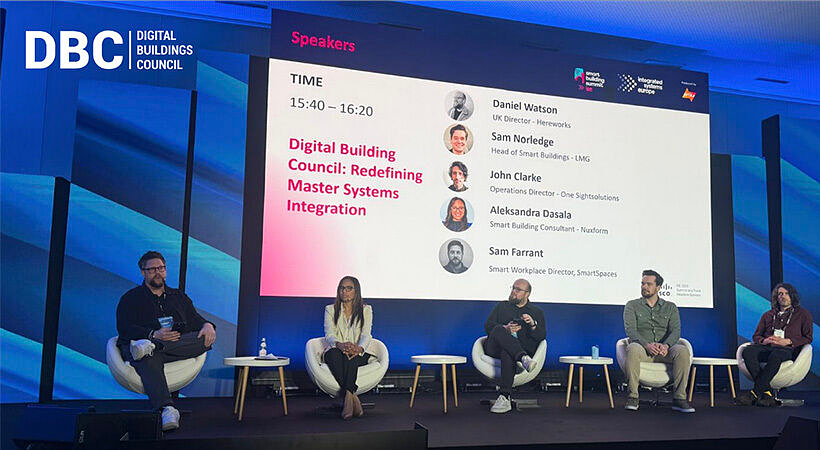
Part of my new role at the Digital Buildings Council (DBC) involves helping put together panels for members at events in the UK and Europe, as well share summaries written by members and generated by AI Tools. This post includes a feature article in Smart Buildings Magazine by John Clarke, operations director at One Sightsolutions, that builds upon the insights shared during the “DBC Redefining Master Systems Integration” panel at ISE Smart Buildings Summit 2025 in Barcelona – exploring the key challenges, emerging trends and actionable strategies shaping the future of MSIs, offering a deeper dive into the topics that resonated most strongly with the audience and panellists alike. I have also incuded an AI summary below and you can listen to an AI-generated podcast discussion over on LinkedIn.
Smart Buildings Magazine: Redefining Master Systems Integration
Digital Buildings Council (DBC) members recently met to discuss “Redefining Master Systems Integration” as part of the ISE Smart Buildings Summit 2025 in Barcelona with the following industry experts: John Clarke, Operations Director at One Sightsolutions LTD; Sam Norledge, Head of Smart Buildings at LMG; Daniel Watson, UK Director at Hereworks; Aleksandra Dasala MIET, Smart Building Consultant at Nuxform; and Sam Farrant, Smart Workplace Director at Smart Spaces (moderator).
The session delved into the evolving role of the Master Systems Integrator (MSI) in today’s increasingly complex smart building landscape. This article serves as a follow-up to explore what was discussed further and provide some actionable insights.
As the panellists are immersed in the day-to-day realities of smart building implementation, we were keen to bring a real-world perspective to the discussion, hopefully, including: the insights from the technical teams on the ground; grappling with the complexities of integrating disparate systems; troubleshooting unforeseen challenges; and ultimately delivering functional, real-world solutions. This hands-on experience often contrasts with the overly optimistic and sales-driven narratives presented by some vendors in the market. While they sometimes paint a picture of seamless integration and effortless deployment, the reality is far too often more nuanced. With gaps between marketing promises and practical limitations, the key for consultants and MSIs is often to help in navigating the technical hurdles and logistical complexities that can arise during a project. We’re hoping these insights offer a valuable counterbalance to the potentially misleading claims of vendors, providing a grounded perspective on what is achievable, and how to realistically bridge the gap between vision and execution.
We believe the role of the Master Systems Integrator is undergoing a significant transformation, driven by technological advancements such as the move to more cloud services and the rapid advancement of AI, as well as evolving client needs. Crucially, these evolving needs are often driven by clients’ growing understanding of the technology itself. As they become more informed about the capabilities and potential of these advancements, clients are developing more sophisticated expectations and demanding solutions that deliver tangible business outcomes.
One of the key challenges in smart building projects is the lack of clarity regarding the roles of vendors, integrators, and consultants. This ambiguity often leads to overlapping responsibilities and miscommunication, hindering project efficiency. To address this, we are seeing an increasing need for a clearer understanding of each stakeholder’s contribution. MSIs need to be more than just installers; they should act as educators, communicating the intricacies of smart building systems to all trades involved.
A reoccurring theme on most smart building projects is the call for early project engagement. This early engagement and open communication are critical for project success. It’s key to emphasise the need for greater education within the market, particularly for architects and project managers, regarding the costs and complexities of smart building integrations. Open communication among all stakeholders, including consultants, clients, and trades, is absolutely essential, especially in projects that deviate from the original design. When changes arise – and they inevitably do in complex projects – a transparent and proactive communication strategy becomes paramount.
This means not only informing everyone of the changes, but also explaining the why behind them, the potential impact on timelines and budget, and soliciting feedback. Critically, this also ensures that the client’s vision and expectations remain at the forefront. By actively engaging the client in discussions about changes, the project team can ensure that the final deliverable still aligns with their desired outcomes, even if the path to get there has shifted. A direct client approach is becoming more commonly favoured, ensuring the client’s needs are prioritised over the need to just get a project completed. And even if the role is through a main contractor, direct engagement between the client and the MSI leads to better outcomes, ensuring that the client’s vision is effectively translated into the final product.
The MSI’s involvement should extend beyond the initial installation. Their role is vital throughout the digital building’s lifespan, not just during the initial setup. Practical completion should mark the beginning of a continuous journey. MSIs should maintain data flow, update systems to ensure security, and serve as an ongoing knowledge base, guiding new software platform implementations. However, current specification practices often pose challenges. Specifications tend to focus on “use cases” rather than “outcomes” and “success metrics,” frequently lacking detail on hardware, software, and integration points. This can lead to inconsistencies, delays, and increased costs.
Looking ahead, the future holds exciting possibilities for MSIs. AI is recognised as a crucial element, but data standardisation is essential for its effectiveness. The MSI’s role is already evolving into validating data formats from a purely system integration one, as well as educating others on smart system adoption. Companies will highlight their strengths within the smart building ecosystem, whether in network, software, or hardware. The industry must collaborate to create and adopt standards to move beyond its current “wild west” phase.
Given their broad exposure to both successful and problematic projects, MSIs are uniquely positioned to educate the industry, sharing valuable technical insights to improve smart building implementations. However, their unique suitability goes beyond simply observing successes and failures. The very nature of the MSI role places them at the epicenter of smart building development. It’s not just about connecting disparate systems; it’s about true integration.
While enterprise networking focuses on connectivity, the MSI’s expertise lies in orchestrating these connected systems to work together seamlessly and intelligently. They understand the nuances of how different technologies interact, anticipate potential conflicts, and develop solutions that optimise performance across the entire building ecosystem. This deep understanding, born from the intrinsic nature of integrating everything from HVAC and lighting to security and building management systems, distinguishes the MSI from other players in the smart building space. They are the architects of the intelligent building, translating client needs and technological possibilities into a cohesive and functional whole, ensuring the building is not just connected, but truly smart.
MSIs should take a proactive approach to education, developing and delivering targeted training programs for various stakeholders. For building service trades and contractors, these programs should focus on the specific integration requirements, spanning from individual systems to cloud connectivity. Training should cover best practices for each integration method, including the proper deployment and management of communication protocols for each integrated system.
This could involve hands-on workshops, on-site demonstrations, and easily accessible online resources. For end clients, MSIs should provide clear and concise explanations of the smart building systems, emphasising the benefits and functionalities most relevant to their specific needs. Interactive presentations, user-friendly guides, and personalised walkthroughs of the integrated technologies would be highly beneficial. To establish themselves as trusted advisors, MSIs should also create and share valuable content, such as white papers, webinars, and case studies, showcasing the latest trends and best practices in smart building integration.
This ongoing educational effort will raise the overall knowledge level within the industry, ultimately helping to avoid costly rework and ensuring projects are designed with integration in mind from the outset.
During the talk, a key discussion point explored the evolving roles within building projects, specifically whether MSIs will replace M&Es’ digital contractual responsibilities. Some participants noted the rapid expansion of Extra Low Voltage Services (ELVS) and its connection to the rise of the “digital main contractor.” The consensus seemed to be that MSIs must adapt to this evolution, carving their own niche rather than forcing industry change. While traditional M&E remains vital, the growing complexity of converged networks, intelligent BMS, IoT, and security systems requires specialised expertise, driving the “Redefining MSI” movement. Developing this digital expertise allows MSIs to offer a valuable proposition to main contractors. This is an area ripe for further exploration, and likely to be the focus of future DBC sessions.
Questions are now starting to arise regarding the potential of open-source AI tools within the smart building sector, prompting interesting discussions on how these technologies could be leveraged to enhance building performance and occupant experience.
For clients with stringent data privacy concerns, utilising open-source AI offers a compelling alternative. By deploying and managing their own instances of open-source AI models, these clients retain complete control over their data, the algorithms processing it, and the resulting output.
This eliminates the need to share sensitive information with external vendors or cloud providers, mitigating the risks associated with data breaches and unauthorised access. Owning the AI instance also allows for greater transparency and auditability, enabling clients to understand precisely how their data is being used and ensuring compliance with relevant regulations.
Furthermore, the ability to train and fine-tune these models with their own proprietary data allows for the development of highly specialised and accurate solutions tailored to their specific needs, potentially offering a competitive advantage. This localised approach empowers clients to leverage the power of AI while maintaining the highest levels of data security and confidentiality.
To ensure the successful deployment and ongoing usage of smart building technologies, several actions are recommended, including:
- Prioritise education for all stakeholders on smart building technologies and integration processes.
- Promote early engagement by involving MSIs earlier in the design phase to improve integration and system compatibility.
- Encourage direct procurement by clients to ensure their needs and outcomes are met.
- Develop more detailed specifications that include specific hardware, software, and integration points.
- Recognise the MSI’s ongoing role beyond project completion for smooth adoption and data management.
- Advocate for data standard adoption to support multiple software platforms, AI tooling and other new technologies.
- Address the skills shortage by recruiting and training engineers to meet the growing demand in smart buildings.
By prioritising education, collaboration and embracing new technologies, the industry can unlock the true potential of smart buildings. This will lead to more efficient, sustainable, and intelligent built environments that are ready for the challenges and opportunities of the future.
AI Summary of Panel
Executive Summary:
While some recent industry discussions question the value of appointing a proven Master System Integrator (MSI) to oversee digital building projects, others see the role being redefined and evolving in different directions. This discussion between those designing, commissioning and integrating smart technologies looks at the changing nature of the role, the challenges being faced, lessons learned and what’s on the horizon:
Participants:
· John Clarke, Operations Director – One Sightsolutions LTD
· Sam Norledge, Head of Smart Buildings – LMG (lmgiq.com)
· Daniel Watson, UK Director – Hereworks
· Aleksandra Dasala MIET , Smart Building Consultant – Nuxform
· Sam Farrant, Smart Workplace Director – Smart Spaces® (Moderator)
The panel discussion focused on challenges related to roles and responsibilities within the industry. The discussion highlights the confusion surrounding the roles of vendors, integrators, and consultants, particularly regarding overlapping specialisms and communication breakdowns. Participants emphasise the importance of early engagement and education to mitigate these issues, advocating for clearer definitions of roles and a more collaborative approach to project delivery. The use of analogies, such as the healthcare system, helped illustrate the complexities and the need for improved communication and standardised processes throughout the project lifecycle. Future roles for professionals were also considered, anticipating a shift towards validation and data standardisation, leveraging AI and low-code/no-code platforms.
Key Themes & Ideas:
Clarity of Roles and Responsibilities:
- Challenge: A major hurdle in smart building projects is the lack of clarity regarding the roles of vendors, integrators, and consultants. There’s often overlap, confusion, and a disconnect in understanding what each brings to the table.
- Quote: Aleksandra Dasala notes: “one of the things not well understood is the overlap and duplication between the different roles, e.g. consultants and contractors, as well as who brings what specialism to the table.”
- MSI as ‘Therapists’: Sam Norledge uses the analogy of the medical profession to explain the role of each stakeholder: Consultants are like doctors providing a diagnosis, MSIs are like therapists providing treatment, and software vendors are like pharmaceutical companies. The crucial point is the “diagnosis” must be correct to guide the integration of systems.
- MSI as Educators: John Clarke observes the MSI role as not just installing hardware, but as educators who communicate and explain what is required to other trades involved in the smart building ecosystem.
The Importance of Early Engagement and Communication:
- Education is Key: The panel agrees on the need for more market education, especially to architects and project managers, who often lack understanding of the costs and work involved with smart building integrations.
- Quote: Dan Watson mentions the goal of the DBC was to help with market education including helping define and explain roles and responsibilities. It is bigger than any one role, so explaining these has an important part to play early on before any of us get products.”
- Communication is Key: The importance of open communication between all stakeholders – consultants, clients, and trades is emphasised, particularly when projects are not designed ideally from the outset. This open comms prevents a mismatch in expectations.
- Quote: John Clarke states : “The key is just communicate and just talk. You need to have a really open communication with consultants, with the end client, with all the trades”.
Procurement Routes and Client Direct Approach:
- Direct to Client Preference: There is a strong sentiment that direct engagement between the client and the MSI yields better outcomes as it ensures that the client’s needs are met. This is prioritised over going through a main contractor.
- Quote: Alexandra Dasala states ” suggest to having a client direct approach, so that we make sure their outcomes are delivered at the end rather than engineered.”
- Benchmarking: The panel support using benchmarking to showcase different integration options to the end user. This approach is harder to execute when under an EM contractor, who they believe might not have the budget.
The MSI’s Role Beyond Practical Completion (PC):
- Long-term Engagement: There’s a consensus that the MSI role is crucial after practical completion (PC) and through the lifespan of the digital building – not just at the time of installation. The panel state that PC is when the “journey starts” rather than finishes.
- Quote: John Clarke suggests, “every project that we’ve delivered to-date as an MSI we say it’s critical that we’re there from PC onwards because generally PC is the start of the journey and we’re just lining everything up ready to go.”
- Ongoing Management: The MSI must be involved in maintaining the data flow, renaming and updating systems, etc. As a result, they can act as an ongoing knowledge base for the building, and help guide new software platform implementations.
Challenges with Current Design & Specification Practices:
- Use Case Focused Specs: There is a critique that many current specifications are too focused on “use cases” and not enough on “outcomes” and “success metrics”, plus lacking detail on hardware, software, and integration points. This lack of detail leads to variations, delays, and increased costs.
The Future of the MSI and the Smart Building Space:
- AI and Data: The panel agrees that AI is a key part of the future, however standardising data and structures is crucial for it to be effective.
- Low Code/No Code Platforms: Alexandra sees value in low-code/no-code platforms to empower FM teams to manage integrations, whilst also speeding up the process of data normalisation.
- MSI as Validators and Educators: In the future, the role of the MSI will evolve into being more of a validator of data formats and system integration, rather than doing the data integration themselves. MSIs will also be educators, assisting with the adoption of the smart systems.
- Focus on specialisations: Panel members agreed that companies will demonstrate their strengths within the ecosystem of smart buildings whether that is network, software or hardware.
- Standards: The industry as a whole has to work on creating and adopting standards to move out of the “wild west” phase of the smart building sector.
Actionable Insights:
- Improve Education: The industry must prioritize educating all stakeholders, including architects, project managers, and trades, on smart building technologies and integration processes.
- Promote Early Engagement: Advocate for earlier involvement of MSIs in the design phase to ensure better integration and system compatibility.
- Direct Procurement: Encourage clients to procure MSIs directly to ensure their needs and outcomes are met.
- Standardise Specifications: Push for more detailed specifications that include specific hardware, software, and integration points, rather than focusing solely on use cases.
- Long-Term Vision: Recognize the importance of the MSI’s role beyond project completion to facilitate smooth adoption and ongoing data management of systems.
- Embrace Industry Standards: MSIs must advocate for the adoption of data standards to support the use of AI and other new technologies in smart buildings.
- Address Skills Shortage: The industry needs to recruit and train engineers to meet the growing demand in smart buildings.
Conclusion:
The panel discussion highlights a critical juncture for the smart building industry. The successful deployment of smart building technologies hinges on overcoming the present challenges in role definition, communication, procurement, and specification. By prioritizing education, collaboration, and embracing new technologies, the industry can unlock the true potential of smart buildings, leading to more efficient, sustainable and intelligent built environments.



